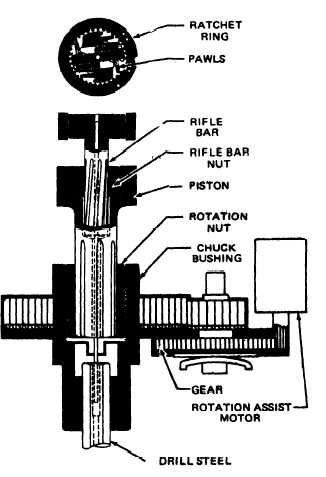TM 5-3820-241-34
through air passage. Instantly, the exhaust port
opens and the pressure in the’air chamber drops
to near atmospheric.
Similarly, on the return
stroke (right hand view) the piston uncovers the
kick port which admits air pressure to the front
side of the valve, shutting off the air supply to the
back end of the cylinder.
(3) Rotation System (figure 5-6). Shows a
line assembly for parts that cause rotation of the
drill steel. Starting at the bottom, the hexagonal
drill steel fits into a hexagonal hole in the chuck
which in turn engages the chuck bushing. The
chuck nut in the bushing engages the straight
splines on the shank of the piston, hence, rotation
of the piston will cause rotation of the drill steel.
The rifle nut in the head of the piston engages the
spiral flutes on the rifle bar. If the rifle bar were
not held still as the piston travels back and forth
in the cylinder,
it would rotate first in one
direction on the power stroke and the opposite
direction on the return stroke. The ratchet
mechanism permits the rifle bar to rotate while
the piston
is making its power stroke, but
prevents it from turning while the piston makes
its return stroke. Consequently, the piston must
rotate as it makes the return stroke, and since it is
connected to the drill steel through the chuck nut
and chuck the drill steel also rotates.
ME 3820-241-34/5-6
Figure 5-6. Drifter drill rotation system.
5-8



